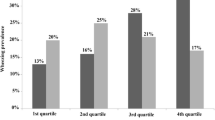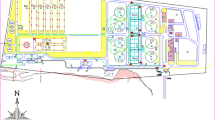Abstract
Endotoxins (lipopolysaccharides) in aerosols, originating from cyanobacteria and gram-negative bacteria, were the likely etiological agent behind outbreaks of a transient, flu-like syndrome, described from four Scandinavian towns and Harare, Zimbabwe. The syndrome with fever, malaise, muscle pains, tightness of the chest and respiratory-tract symptoms, also known as toxic pneumonitis, occurred 1.5–6 hours after taking a bath or shower. The outbreaks were associated with mass developments of cyanobacteria in the drinking water reservoirs. Cyanobacterial cells and elevated levels of endotoxins were detected in the Harare tap water when human subjects reported symptoms. In a field study of 21 water bodies, the concentrations of endotoxins were much higher in water dominated by cyanobacteria, compared to water with dominance of eukaryotic algae. This observation may partially be explained by the fact that cyanobacteria possess endotoxins and partially by our findings that endotoxin-possessing bacteria inhabit the mucilage of several mass developing cyanobacterial taxa.




Similar content being viewed by others
References
Annadotter H (1993) Cyanobacterial Toxins in Drinking Water. VA-Forsk Rapport 1993-03 ISBN 91-88392-42-2 (in Swedish with an English abstract)
Annadotter H, Cronberg G, Aagren R, Lundstedt B, Nilsson PÅ, Ströbeck S (1999) Multiple techniques for the restoration of a hypertrophic lake. In: Harper D, Brierly W, Phillips G, Fergusson A (eds), The Ecological Basis for Lake and Reservoir Management, Hydrobiologia 395/396. Dordrecht/Boston/London:
Atterholm I, Ganrot-Norlin K, Ringertz O (1978) Fever attacks after bath tub baths. Läkartidningen 75:549–551 (in Swedish with an English abstract)
Barbiero RP, Welch EB (1992) Contribution of benthic blue-green algal recruitment to lake populations and phosphorus translocations. Freshwater Biology 27:249–260
Bernhardt H, Clasen J (1991) Flocculation of micro-organisms. Journal of Water Supply: Research and Technology–Aqua 40:76–87
Björk S (1972) Swedish Lake restoration programme gets results. AMBIO 1:154–165
Chorus I (2001) Cyanotoxins—Research for Environmental Safety and Human Health. In: Chorus I (ed), Cyanotoxins, Occurrence, Causes, Consequences, Berlin/Heidelberg/New York: Springer-Verlag, pp 1–4
Cronberg G (1982) Phytoplankton changes in Lake Trummen induced by restoration. Folia Limnologica Scandinavica 18:1–119
Cronberg G (1996) Cyanophytes in Scanian Lakes during the 20th Century, Lund, Sweden: Institute of Ecology, Lund University
Delport SD, Brisley T (2002) Aetiology and outcome of severe community-acquired pneumonia in children admitted to a paediatric intensive care unit. South African Medical Journal 92:907–911
DiLuzio NR, Friedmann TJ (1974) Bacterial endotoxins in the environment. Nature 244:559–562
Drews G, Weckesser J (1982) Fine structure and chemical composition of the cell envelopes. In: The Biology of Cyanobacteria, Carr NG, Whitton BA (editors), Oxford, UK: Blackwell Scientific Publications, pp 96–116
Gibson CE (1978) Carbohydrate content as an ecological tool in the study of planktonic blue-green algae. Verhandlungen der Internationale Vereinigung für theoretische und angewandte Limnologie 20:630–635
Heise HA (1949) Symptoms of hay fever caused by algae. Journal of Allergy 20:383–385
Herbert A, Carvalheiro M, Rubenowitz E, Bake B, Rylander R (1992) Reduction of alveolar-capillary diffusion after inhalation of endotoxin in normal subjects. Chest 102:1095–1098
Hindman SH, Carson LA, Favero MS, Petersen NJ, Schonberger LB, Solano JT (1975) Pyrogenic reactions during haemodialysis caused by extramural endotoxin. The Lancet 2:732–734
Istvánovics V, Pettersson K, Rodrigo MA, Pierson D, Padisák J, Colom W (1993) Gloeotrichia echinulata, a colonial cyanobacterium with a unique phosphorus uptake and life strategy. Journal of Plankton Research 15:531–552
Jorgensen JH, Lee JC, Pahren HR (1976) Rapid detection of bacterial endotoxins in drinking water and renovated wastewater. Applied and Environmental Microbiology 32:347–351
Keinänen MM, Korhonen LK, Lehtola MJ, Miettinen IT, Martikainen PJ, Vartiainen T, et al. (2002) The microbial community structure of drinking water biofilms can be affected by phosphorus availability. Applied and Environmental Microbiology 68:434–439
Keleti G, Sykora JL (1982) Production and properties of cyanobacterial endotoxins. Applied and Environmental Microbiology 43:104–109
Larsson K, Weibull C, Cronberg G (1978) Comparison of light and electron microscopic determinations of the number of bacteria and algae in lake water. Applied and Environmental Microbiology 35:397–404
LeChevallier MW, Cawthon CD, Lee RG (1988). Factors promoting survival of bacteria in chlorinated water supplies. Applied and Environmental Microbiology 54:649–654
Levin J (1987) The limulus amebocyte lysate test: perspectives and problems. In: Stanley WW, Levin J (eds), Detection of Bacterial Endotoxins with the Limulus Amebocyte Lysate Test, New York: Alan R. Liss, pp 1–23
Levin J, Bang FB (1968) Clottable protein in limulus: its localization and kinetics of its coagulation by endotoxin. Thrombosis et Diathesis Haemorrhagica 19:186–197
Martin C, Codd GA, Siegelman HW, Weckesser J (1989) Lipopolysaccharides and polysaccharides of the cell envelope of toxic Microcystis aeruginosa strains. Archives of Microbiology 152:90–94
McMichael AJ (2001) Human Frontiers, Environments and Disease: Past Patterns, Uncertain Futures, UK: Cambridge University Press
Michel O, Duchateau J, Sergysels R (1989) Effect of inhaled endotoxin on bronchial reactivity in asthmatic and normal subjects. Journal of Applied Physiology 66:1059–1064
Michel O, Nagy AM, Schroeven M, Duchateau J, Neve J, Fondu P, et al. (1997) Dose-response relationships to inhaled endotoxin in normal subjects. American Journal of Respiratory and Critical Care Medicine 156:1157–1164
Moyo NAG (1997) Causes of massive fish deaths in Lake Chivero. In: Moyo NAG (ed), Lake Chivero: a Polluted Lake, Harare, Zimbabwe: University of Zimbabwe Publications, pp 98–104
Munoz C, Carlet J, Fitting C, Bisse B, Blériot JP, Cavaillon JM (1991) Dysregulation of in vitro cytokine production by monocytes during sepsis. The Journal of Clinical Investigation 88:1747–1754
Muittari A, Kuusisto P, Virtanen P, Sovijärvi A, Grönroos P, Harmoinen A, et al. (1980a) An epidemic of extrinsic allergic alveolitis caused by tap water. Clinical Allergy 10:77–90
Muittari A, Rylander R, Salkinoja-Salonen M (1980b) Endotoxin and bath water fever. The Lancet 2:89
Paerl HW, Fulton RS, Moisander P, Dyble J (2001) Harmful freshwater algal blooms, with an emphasis on cyanobacteria. The Scientific World 1:76–113
Pettersson K, Herlitz E, Istvánovics V (1993) The role of Gloeotrichia echinulata in the transfer of phosphorus from sediments to water in Lake Erken. Hydrobiologia 253:123–129
Pilotto LS, Douglas RM, Burch MD, Cameron S, Beers M, Rouch GR, et al. (1997) Health effects of exposure to cyanobacteria (blue-green algae) due to recreational water-related activities. Australian and New Zealand Journal of Public Health 21:562–566
Rapport D, Regier HA, Hutchinson TC (1985) Ecosystem behavior under stress. The American Naturalist 125:617–640
Rapport DJ, Whitford WG (1999) How ecosystems respond to stress. BioScience 49:193–203
Rapport DJ, Constanza R, McMichael AJ (1998) Assessing ecosystem health: challenges at the interface of social, natural and health sciences. Trends in Ecology and Evolution 13:397–402
Rapport DJ, Christensen N, Karr JR, Patil GP (1999) The centrality of ecosystem health in achieving sustainability in the 21st century. In:, Hayne DM (ed), Concepts and New Approaches to Environmental Management, Transactions of the Royal Society of Canada, Series V1, v.1X, Toronto, Canada: University of Toronto Press, pp 3-40
Raveh D, Rudensky B, Schlesinger Y, Benenson S, Yinnon AM (2003) Susceptibility trends in bacteraemias: analyses of 7544 patient-unique bacteraemic episodes spanning 11 years (1990–2000). Journal of Hospital Infection 55:196–203
Reechaipichitkul W, Pisprasert V (2004) Severe community-acquired pneumonia (CAP) treated at Srinagarind Hospital, Khon Kaen, Thailand. Southeast Asian Journal of Tropical Medicine and Public Health 35:430–433
Robinson A, McCarter YS, Tetreault J (1995) Comparison of Crystal Enteric/Nonfermenter System, API 20E System, and Vitek Automicrobic System for identification of gram-negative bacilli. Journal of Clinical Microbiology 33:364–370
Rylander R (2002) Endotoxin in the environment—exposure and effects. Journal of Endotoxin Research 8:241–252
Rylander R, Bake B, Fischer JJ, Helander IM (1989) Pulmonary function and symptoms after inhalation of endotoxin. American Review of Respiratory Diseases 140:981–986
Sandström T, Bjermer L, Rylander R (1992) Lipopolysaccharide (LPS) inhalation in healthy subjects increases neutrophils, lymphocytes and fibronectin levels in brochoalveolar lavage fluid. European Respiratory Journal 5:992–996
Shapiro J, Lamarra V, Lynch M (1975) Biomanipulation: an ecosystem approach to lake restoration. In: Brezonik PL, Fox JL (eds), Proceedings of a Symposium on Water Quality Management through Biological Control, Gainesville, FL: University of Florida Press, pp 85–96
Stockner JG, Callieri C, Cronberg G (2000) Picoplankton and other non-bloom forming cyanobacteria in lakes. In: Whitton BA, Potts M (eds), The Ecology of Cyanobacteria—Their Diversity in Time and Space, Dordrecht/London/Boston: Kluwer Academic Publishers, pp 195–231
Thorn J, Rylander R (1998) Inflammatory response after inhalation of bacterial endotoxin assessed by the induced sputum technique. Thorax 53:1047–1052
Tracey KJ, Beutler B, Lowry SF, Merryweather J, Wolpe S, Milsark I, et al. (1986) Shock and tissue injury induced by recombinant human cachectin. Nature 234:470–474
Tracey KJ, Fong Y, Hesse DG, Manogue KR, Lee AT, Kuo GC, et al. (1987) Anti-cachetin/TNF monoclonal antibodies prevent septic shock during lethal bacteraemia. Nature 330:662–664
Van der Kooij D (1992) Assimilable organic carbon as and indicator of bacterial regrowth. Journal of American Water Works Association 84:57–65
van der Wende E, Characklis WG, Smith DB (1989) Biofilms and bacterial drinking water quality. Water Research 23:1313–1322
Walsby AE (1994) Gas vesicles. Microbiological Reviews 58:94-144
Weise G, Drews G, Jann B, Jann K (1970) Identification and analysis of a lipopolysaccharide in cell walls of the blue-green alga Anacystis nidulans. Archives of Microbiology 71:1–3
Whitton BA (1973) Interactions with other organisms. In: Carr NG, Whitton BA (eds), The Biology of Blue-green Algae, Oxford/London/Edinburgh/Melbourne: Blackwell Scientific Publications, pp 415–433
Whitton BA, Potts M (2000) Introduction to the cyanobacteria. In:Whitton BA, Potts M (eds), Ecology of Cyanobacteria—Their Diversity in Time and Space Dordrecht/London/Boston: Kluwer Academic Publishers, pp 195–231
WHO (2004) Guidelines for Drinking-water Quality, 3rd ed., Vol 1, Recommendations, Geneva: World Health Organization
Willén T (1962) The Utål lake chain, central Sweden and its phytoplankton. Oikos Supplement 5:1–156
Worm J, Søndergaard M (1998) Dynamics of heterotrophic bacteria attached to Microcystis spp. (Cyanobacteria). Aquatic Microbial Ecology 14:19–28
Yoshimoto T, Nakanishi K, Hirose S, Hiroishi K, Okamura H, Takemoto Y, et al. (1992) High serum IL−6 level reflects susceptible status of the host to endotoxin and IL-1/tumor necrosis factor. The Journal of Immunology 148:3596–3603
Acknowledgments
This study was supported by a grant from Kristianstad University, Sweden. We are thankful to Paul Meehan for technical assistance during the sampling at Lake Chivero. We acknowledge with gratitude the work done under our supervision by Heidi Savelli Söderberg, Jenny Nilsson, Susanne Gustafsson, and Lindah Mhlanga for the pond study in Kariba.
Author information
Authors and Affiliations
Corresponding author
Rights and permissions
About this article
Cite this article
Annadotter, H., Cronberg, G., Nystrand, R. et al. Endotoxins from Cyanobacteria and Gram-negative Bacteria as the Cause of an Acute Influenza-like Reaction after Inhalation of Aerosols. EcoHealth 2, 209–221 (2005). https://doi.org/10.1007/s10393-005-5874-0
Received:
Accepted:
Published:
Issue Date:
DOI: https://doi.org/10.1007/s10393-005-5874-0




